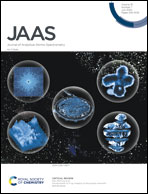Dried droplet calibration approach for the analysis of inorganic nonmetallic materials by laser ablation-inductively coupled plasma-mass spectrometry
Abstract
A simple and general dried droplet calibration approach was developed for the quantitative analysis of elements in inorganic nonmetallic materials using laser ablation inductively coupled plasma mass spectrometry (LA-ICP-MS). For quantitative analysis, the elemental distribution in dried droplets was improved by optimizing the amount of a surfactant (Pluronic F-127) added into the calibration solutions and the drying temperature. Under optimal conditions, at 2.0 wt% Pluronic F-127 in the calibration solutions and a drying temperature of 85 °C, the relative standard deviation of the signal intensity obtained from multi-line ablation mode is less than 20% for dried droplets. Meanwhile, the experimental results revealed that dried droplets have no effect on the ablation of the sample and dried droplets can be totally ablated in one ablation raster. Further, the method was applied to analyze several inorganic non-metallic materials such as yttrium aluminum garnet (YAG) ceramic, BaF2 crystal, and NIST SRM 612 glass. The linear correlation coefficients of the calibration curves ranged from 0.9936 to 0.9999 without any internal standard correction. Moreover, the results agree well with the results obtained by inductively coupled plasma atomic emission spectrometry or inductively coupled plasma atomic mass spectrometry and certified values.



 Please wait while we load your content...
Please wait while we load your content...